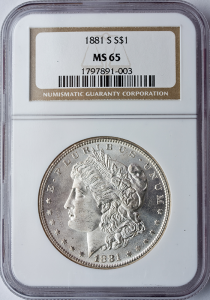1921 Circulated American Silver Morgan Dollar (Types Vary)





| The Morgan Dollar is a unique coin, cherished deeply by those who collect it. This silver dollar’s notable heft and size — almost as big as the palm of your hand — make it one of the most distinctive coins in American numismatics. This unusual size, 1.5 inches in diameter, likely stems from the sheer quantity of silver flooding the state of Nevada at the time. The Comstock Lode in Nevada was producing silver worth a million dollars each week, which presented an economic challenge: with too much supply and not enough demand for this silver, Nevada’s economy could implode. In stepped Uncle Sam (at the urging of lobbyists). Congress passed the Bland-Allison Act of 1878 over President Hayes’ veto, requiring the U.S. Treasury to buy $2-$4 million of silver every month and turn it into silver coin. George T. Morgan, an engraver at the Mint, designed the new silver dollar. The obverse featured Lady Liberty’s head, and the reverse featured an eagle. Less than two weeks after Congress authorized the coin, the first Morgan Dollar was struck: on March 11, 1878. Minting stopped in 1904, although the Morgan Dollar was again minted in 1921 and then re-retired. In 1918, over 270 million Morgan Dollars were melted down, and the silver was sold to Great Britain, which required financial relief after a war-time run on silver. Millions more were melted down over the years. The law that authorized the melting also stipulated that all the melted-down silver coins be replaced, which is how the 1921 Morgan Dollar came to be. Unfortunately, the original dies had been discarded and the Mint had to make new ones, resulting in coins that looked quite different from the earlier issues. That year, mints in Philadelphia, Denver, and San Francisco all produced a record number of Morgan Dollars. The Morgan Dollar is one of the most collected classic American coin series, collected by millions of people. For those looking to dive into collecting, Morgan Dollars offer an affordable entry point. We recommend starting with an 1878 issue, choosing a specific mint mark, and progressively adding new dates. Once you've covered all years of minting, you can build out your collection further by looking for additional mint marks from each year, along with any intriguing errors and variations. |






 Quick View
Quick View





